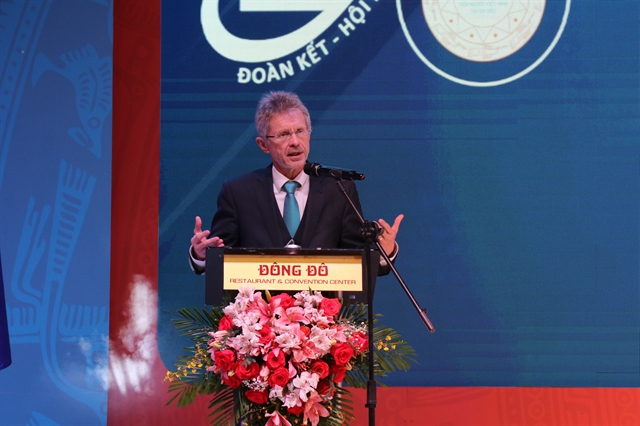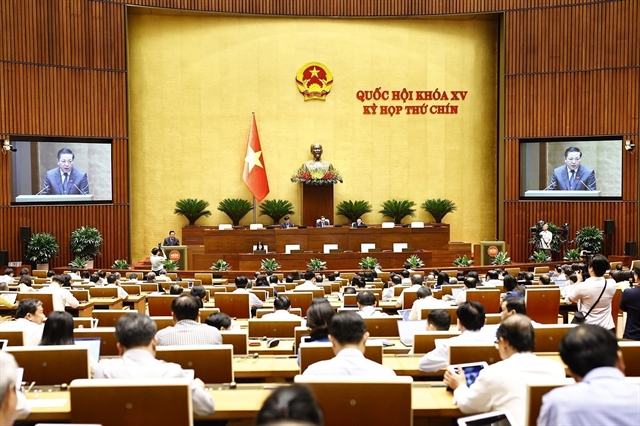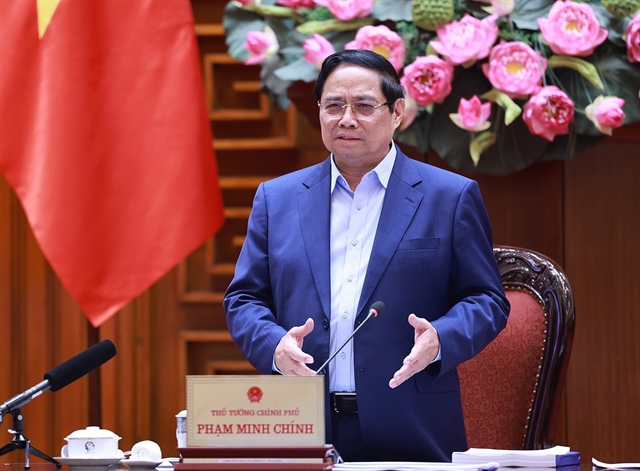 Politics & Law
Politics & Law

 |
| The National Assembly's 9th session discussing the investment policy for the Quy Nhơn – Pleiku Expressway and proposed adjustments to Phase 1 of the Biên Hòa – Vũng Tàu Expressway. VNA/VNS Photo |
HÀ NỘI — The National Assembly (NA) on Monday deliberated the investment policy for two key expressways - the Quy Nhơn – Pleiku Expressway and proposed adjustments to Phase 1 of the Biên Hòa – Vũng Tàu Expressway, as part of its 9th session.
Presenting the proposal for the Quy Nhơn – Pleiku Expressway, Minister of Construction Trần Hồng Minh stressed the urgency of investing in the project.
He pointed out that the current road connections between Gia Lai and Kon Tum provinces with Bình Định and the south central coastal region, primarily via national highways, only met basic transport demands and have not attracted significant investment. This, he said, was due to high transportation costs and long travel times, hindering the development potential of agriculture, processing industries, renewable energy and tourism in Gia Lai and Kon Tum.
The plans show the expressway starting at National Highway 19B in An Nhơn Town, Bình Định Province and ending at Hồ Chí Minh Road in Pleiku City, Gia Lai Province, with a total length of approximately 125 km.
It will traverse An Nhơn Town and Tây Sơn District in Bình Định Province, An Khê Town, the districts of Đắk Pơ, Mang Yang, Đắk Đoa and Pleiku city in Gia Lai Province.
The project is designed as a four-lane highway with continuous emergency stopping lanes, a road width of 24.75 metres, and a design speed of 100 kph. The estimated land use is around 942.15 hectares.
The proposed investment method is public investment, with a preliminary total budget of approximately VNĐ43.73 trillion (US$1.68 billion). Funding will come from State budget resources, including increased revenue and expenditure savings from 2024, and budget allocations from both central and local governments in the 2021–2025 and 2026–2030 periods.
Delivering the verification report, Chairman of the NA’s Economic and Financial Committee Phan Văn Mãi affirmed the necessity of the project. The Committee recommended that, during the feasibility study phase, the Government carefully review and select the most optimal route alignment.
It also advised further scrutiny of infrastructure such as rest stops, intelligent transportation systems, interchanges and supporting structures, ensuring they are built in sync with the main expressway to maximise investment efficiency.
Some lawmakers suggested that, based on projected traffic volumes by 2035, only two or three lanes may be required initially. Therefore, the feasibility study should include a comparative analysis, particularly on whether to construct the full four-lane structure in Phase 1, or agree to any expansion based on traffic growth to avoid unnecessary expenditure.
Regarding the investment format, the committee supported the use of public funding for the project.
Also on Monday, the NA gave preliminary approval to the adjusted investment policy for Phase 1 of the Biên Hòa – Vũng Tàu Expressway, with the total investment rising from VNĐ17.83 trillion ($687.1 million) to VNĐ21.55 trillion ($830.5 million), an increase of 20.8 per cent.
The project spans approximately 53.7 km, with a design speed of 100 kph and four to six lanes. It is divided into three components.
Component 1 of the project spans 16 kilometres and is designed with four lanes, with an estimated total investment of VNĐ6.24 trillion ($240.4 million). Of this amount, approximately VNĐ3.58 trillion ($137.9 million) is allocated for land compensation and resettlement.
Component 2 covers a length of 18.2 kilometres and will feature four to six lanes. Its estimated investment stands at VNĐ6.40 trillion ($246.6 million), including VNĐ1.7 trillion ($65.5 million) for compensation and resettlement.
Component 3 extends 19.5 kilometres with four lanes and has a projected investment of VNĐ5.19 trillion ($200 million), of which VNĐ1.33 trillion ($51.2 million) is designated for compensation and resettlement.
The original funding plan for the project consisted of VNĐ14.27 trillion from the 2021–2025 state budget, including VNĐ11 trillion from central Government funds and VNĐ3.27 trillion from local budgets. In addition, VNĐ3.56 trillion was allocated from the 2026–2030 central budget.
Under the revised proposal, the total investment has increased significantly to VNĐ21.55 trillion, with updated allocations for each project component. Component 1 is now projected to require VNĐ6.69 trillion, the second part VNĐ7.64 trillion and Component 3 VNĐ7.21 trillion.
Accordingly, the budget has been adjusted to reflect the increase. The 2021–2025 state budget is now set at VNĐ17.12 trillion —an increase of VNĐ2.85 trillion —with VNĐ12.14 trillion sourced from central Government funds and VNĐ4.98 trillion from local budgets. For the 2026–2030 period, the central budget has also been raised to VNĐ4.42 trillion, marking an increase of VNĐ860 billion.
The cost increase was attributed to rising land compensation, resettlement expenses and construction costs. However, the committee noted that the 20.8 per cent rise in investment was substantial. It called for a clearer explanation of the causes and greater accountability from the agencies and individuals responsible for the initial project preparation.
To ensure timely funding, the committee urged the Government to clarify the capital sources and ensure funding is balanced. It also asked the Government to take responsibility for the accuracy of cost estimates, commit to meeting deadlines and quality standards and clearly define the project’s completion timeline. — VNS


.jpg)

